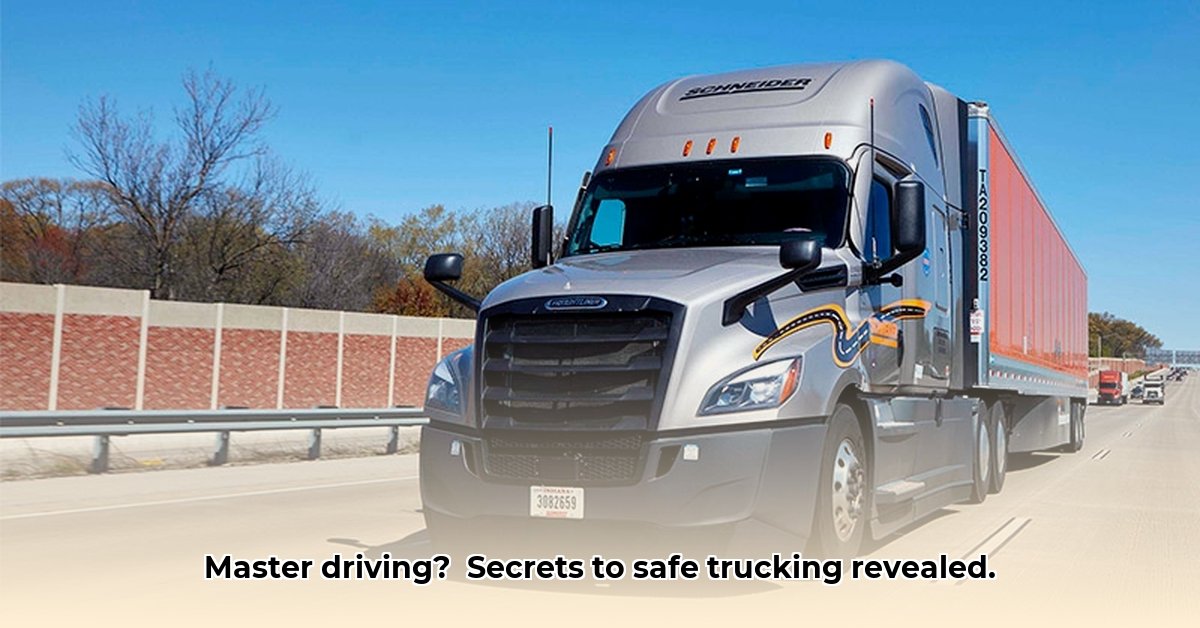
Driving a tractor-trailer demands skill, precision, and a steadfast commitment to safety. This comprehensive guide provides step-by-step instructions and best practices for safe and efficient operation, from pre-trip inspections to routine maintenance. Whether you're a seasoned professional or just starting your journey, this guide will equip you with the knowledge and confidence to navigate the road safely. For more information on specific tractor-trailer models, check out this useful resource.
Pre-Trip Inspection: A Critical First Step
A thorough pre-trip inspection is non-negotiable, forming the bedrock of safe operation. Think of it as a crucial health check for your vehicle; neglecting this step is akin to driving with your eyes closed.
Tire Check: Inspect each tire for proper inflation using a reliable gauge. Look for cuts, bulges, or any signs of damage. Under-inflated tires significantly increase the risk of blowouts and loss of control. Did you know that under-inflated tires account for a significant percentage of roadside breakdowns?
Fluid Levels: Check engine oil, coolant, and hydraulic fluid levels. Low levels can lead to catastrophic engine failure, overheating, or hydraulic system malfunctions. Use only the fluids recommended in your vehicle's manual.
Brake Test: Perform a complete brake test. Ensure responsiveness and consistent braking across all axles. Faulty brakes are a major safety hazard, making this check absolutely critical.
Light Check: Verify that all lights (headlights, taillights, brake lights, turn signals, clearance lights) are functioning correctly. Proper lighting is essential for visibility, especially in low-light conditions or inclement weather. Remember, your lights are your lifeline in adverse conditions.
Cargo and Trailer Inspection (if applicable): If hauling a trailer, thoroughly inspect its lights, brakes, and connections. Ensure the cargo is properly secured to prevent shifting during transit. Improperly secured loads can lead to serious accidents.
Mastering the Controls: Driving a Tractor-Trailer with Confidence
Driving a tractor-trailer involves seamlessly coordinating numerous systems. Smooth operation requires practice and a keen understanding of your vehicle.
Starting and Stopping: Before starting, ensure the transmission is in neutral and the parking brake is engaged. Follow the manufacturer's start-up procedure. For stopping, slow down gradually and utilize your brakes effectively. Sudden stops can be dangerous and place undue stress on your vehicle's components.
Transmission Operation: The 18-speed transmission might seem daunting, but it's a precision instrument. Smooth shifting is crucial for fuel efficiency, engine longevity, and safe operation. Practice makes perfect, and additional training is highly recommended. Mastering the 18-speed transmission can improve fuel efficiency by up to 15%, according to industry data.
Steering and Control: Steer smoothly and predictably. Maintain a safe following distance. Scan the road ahead, anticipating potential hazards and adjusting your speed accordingly. Defensive driving is paramount. Remember to always anticipate the actions of other drivers—never assume they'll act as expected.
Mirror Mastery: Regularly use your mirrors to monitor your surroundings and blind spots. This is crucial for preventing accidents, particularly when changing lanes or making turns. Blind spot collisions are a leading cause of accidents involving large vehicles.
Cargo Handling: Security and Efficiency
Securely handling your cargo is a critical aspect of safe operation. Improperly secured loads can be dangerous and lead to costly delays.
Securement Techniques: Use appropriate straps, chains, and other securing devices tailored to the type and weight of your cargo. Both over- and under-tightening can compromise safety and lead to damage.
Weight Distribution: Even weight distribution is critical. Uneven loads strain your vehicle and increase the risk of accidents. Consult load charts and guidelines to determine the optimal weight distribution for your cargo.
Load Placement: Strategically place heavier items closer to the trailer's axles to maintain balance and stability. This reduces stress on components and enhances overall driving safety.
Safety Procedures: Prioritizing Your Well-being
Safety isn’t optional; it’s non-negotiable.
Personal Protective Equipment (PPE): Always wear a seatbelt. Other PPE, such as safety glasses and gloves, may be necessary depending on the task.
Road Safety Practices: Obey all traffic laws. Drive defensively, anticipating the actions of others and maintaining a safe following distance. Did you know that defensive driving can reduce accident rates by up to 50%?
Emergency Procedures: Familiarize yourself with your vehicle's emergency procedures. Know how to handle breakdowns, tire blowouts, etc., and always keep the relevant emergency contact numbers readily available.
Regular Maintenance: Prevention is Key
Routine maintenance is vital for preventing breakdowns and ensuring safe operation.
Scheduled Maintenance: Adhere to the manufacturer's recommended maintenance schedule for oil changes, fluid checks, and filter replacements.
Fluid Checks: Regularly check all fluid levels (oil, coolant, brake fluid, etc.). Low levels can lead to severe problems.
Tire Pressure Monitoring: Monitor tire pressure frequently, ensuring proper inflation to maximize fuel efficiency and reduce wear.
Troubleshooting Common Issues: Quick Fixes and Professional Help
Being able to address minor problems quickly can prevent major issues. However, don't hesitate to call for professional help when necessary.
| Problem | Possible Cause(s) | Solution |
|---|---|---|
| Engine won't start | Dead battery, fuel issues, starter motor problems | Check battery, fuel system, starter motor. Seek professional assistance if needed. |
| Brake lights out | Burned-out bulb, faulty wiring | Replace the bulb or repair wiring. Professional help may be required. |
| Overheating | Low coolant, faulty thermostat, clogged radiator | Check coolant level and look for leaks. Replace thermostat if needed. Clogged radiator requires professional attention. |
| Trailer lights not working | Faulty wiring, blown bulbs, loose connections | Inspect wiring and connections. Replace bulbs as needed. Professional help might be necessary. |
This guide provides a foundation for safe tractor-trailer operation. Continuous learning and professional training are essential for mastering this complex skill. Prioritize safety above all else – it's your responsibility and the key to safe travels.